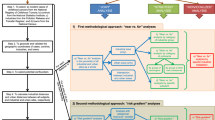Summary
The possible association between selected cancers and polluted work places has been studied in a hospital-based, case-control study. By dividing all jobs in the participants' working career into ‘polluted’ and ‘clean’, a crude measure for the total industrial exposure a worker experiences throughout his life was established. Among 103 age-matched, case-control pairs the overall estimated relative risk (RR) for exposed subjects (≥ 10 years in a polluted work place) of developing cancer compared to nonexposed (< 10 years in a polluted work place) was 1.l. The only subgroup where a significant difference was found between the cases and the controls was the lung cancer subgroup (RR = 4.0, P = 0.02, two-tailed). When the 30 lung cancer cases were compared to an alternative control group consisting of 60 subjects matched for age and smoking habits, an estimated RR of 4.5 was found. A moderate, but not significant association between lung cancer and definite asbestos exposure was also found (RR: 2.3). As most workers are exposed to a variety of industrial agents throughout their working careers, further development of methods for characterizing combined exposures are needed, both for retrospective and prospective purposes.
Similar content being viewed by others
References
Archer VE, Gillam JD, Wagoner JK (1976) Respiratory disease mortality among uranium miners. Ann NY Acad Sci 271:280–293
Axelson O (1978) Aspects on confounding in occupational health epidemiology. Scand J Work Environ Health 4:85–89
Blackwell MJ, French JG, Stein HP (1979) Adverse health effects of smoking and the occupational environment. Am Ind Hyg Assoc J 40:A38-A47; NIOSH Curr Intell Bull 31
Bogovski P (1980) Historical perspectives of occupational cancer. J Toxicol Environ Health 6:921–939
Breslow NE, Day NE (1980) Statistical methods in cancer research, vol 1. The analysis of case-control studies. International Agency for Research into Cancer. IARC Scientific Publications (Lyon) 32, pp 146–154
Bridbord K, Decoufle P, Fraumeni JF, Hoel DG, Hoover RN, Rall DP, Saffiotti U, Schneiderman MA, Upton AC, Day N (1978) Estimates of the fraction of cancer in the United States related to occupational factors. National Cancer Institute, Bethesda, Maryland
Cohen D, Arai SF, Brain JD (1979) Smoking impairs long-term dust clearance from the lung. Science 204:514–517
Hammond EC, Selikoff IJ Relation of cigarette smoking to risk of death to asbestos-associated disease among insulatin workers in the United States. In: Bogovski P, Bogovski P, Gilson JC, Timbrell V, Wagner JC (eds) Biological effects of asbestos. International Agency for Research into Cancer. IARC Scientific Publication No. 8, Lyon, pp 312–317
Higginson J, Muir CS (1979) Environmental carcinogenesis: misconceptions and limitations to cancer control. J Natl Cancer Inst 63:1291–1298
Hoar SK, Morrison AS, Cole P, Silverman DT (1980) An occupation and exposure linkage system for the study of occupational carcinogenesis. J Oral Med 22:722–726
Menck HR, Henderson BE (1976) Occupational differences in rates of lung cancer. J Oral Med 18:797–801
Miettinen OS (1969) Individual matching with multiple controls in the case of all-or-none responses. Biometrics 25:339–354
Miettinen OS (1970) Estimation of relative risk from individually matched series. Biometrics 26:75–86
Miettinen OS (1972) Components of the crude risk ratio. Am J Epidemiol 96:168–172
Miettinen OS (1976) Estimability and estimation in case-referent studies. Am J Epidemiol 103:226–235
Roe FJC, Salamam MH, Cohen J, Burgan JG (1959) Incomplete carcinogens in cigarette smoke condensate: tumor-promotion by a phenolic fraction. Br J Cancer 13:623–633
Selikoff IJ, Lee DHK (1978) Asbestos and disease. Academic Press, New York, pp 307–336
Smith AH, Waxweiler RJ, Tyroler HA (1980) Epidemiologic investigation of occupational carcinogenesis using a serially additive expected dose model. Am J Epidemiol 112:787–797
Stenbäck F, Rowland J, Sellakumar A (1976) Carcinogenicity of benzo(a)pyrene and dusts in the hamster lung (instilled intratracheally with titanium oxide, aluminium oxide, carbon and ferric oxide). Oncology 33:29–34
Tola S (1980a) Occupational cancer of the urinary bladder. J Toxicol Environ Health 6:1253–1260
Tola S (1980b) Epidemiology of lung cancer in foundries. J Toxicol Environ Health 6:1195–1200
van Duuren BL, Sivak A, Segal A, Orris L, Langseth L The tumor-promoting agents of tobacco leaf and tobacco smoke condensate. J Natl Cancer Inst 37:519–526
Vellar OD (1965) Smoking habits among Norwegian seamen and men ashore. The Cancer Society of Norway, Oslo (In Norwegian, English summary)
Williams RR, Stegens NL, Goldsmith JR (1977) Associations of cancer site and type with occupation and industry from the Third National Cancer Survey Interview. J Natl Cancer Inst 59:1147–1161
Author information
Authors and Affiliations
Rights and permissions
About this article
Cite this article
Kjuus, H., Lislerud, A., Lyngdal, P.T. et al. Cancer and polluted work places: A case-control study. Int. Arch Occup Environ Heath 49, 281–292 (1982). https://doi.org/10.1007/BF00377937
Received:
Accepted:
Issue Date:
DOI: https://doi.org/10.1007/BF00377937



